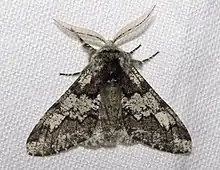| Biston | |
|---|---|
 | |
| Oak beauty, Biston strataria | |
| Scientific classification | |
| Domain: | Eukaryota |
| Kingdom: | Animalia |
| Phylum: | Arthropoda |
| Class: | Insecta |
| Order: | Lepidoptera |
| Family: | Geometridae |
| Tribe: | Bistonini |
| Genus: | Biston Leach, 1815 |
| Synonyms | |
| |
Biston is a genus of large, long-winged moths belonging to the family Geometridae. It is most notable for containing the well-known peppered moth. The genus was first described by William Elford Leach in 1815.

Distribution
The species of Biston are widely distributed in Holarctic, Oriental and Ethiopian regions.
Description
Palpi short and hairy. Thorax stout and clothed with thick pile. Legs hairy. Hind tibia not dilated and with slight spurs present. Forewings with rounded apex and oblique outer margin. Vein 3 from near angle of cell. Veins 7 to 9 stalked from near upper angle and veins 10, 11 stalked, where 10 often connected with veins 8 and 9. Hindwings with long cell and vein 3 from the angle.[1]
Diversity
The genus currently contains 54 species and 40 subspecies.
Species
Species include:
- Biston achyra Wehrli, 1936
- Biston bengaliaria (Guenée, 1857)
- Biston betularia (Linnaeus, 1758) – peppered moth
- Biston brevipennata Inoue, 1982
- Biston bura (Warren, 1894)
- Biston contectaria (Walker, 1863)
- Biston exalbescens Inoue, 2000
- Biston falcata (Warren, 1893)
- Biston giganteus Inoue
- Biston hypoleucus Kuznetsov, 1901
- Biston inouei Holloway, 1993
- Biston insularis (Warren, 1894)
- Biston marginata Shiraki, 1913
- Biston mediolata Jiang, Nan, Dayong Xue & Hongxiang Han, 2011
- Biston melacron Wehrli, 1941
- Biston multidentata (Guedet, 1941)
- Biston panterinaria (Bremer & Grey, 1853)
- Biston pelidna Prout
- Biston perclara (Warren, 1899)
- Biston pustulata (Warren, 1896)
- Biston quercii (Oberthür, 1910)
- Biston regalis (Moore, 1888)
- Biston robustum Butler, 1879
- Biston strataria (Hufnagel, 1767) – oak beauty
- Biston subregalis Inoue
- Biston suppressaria (Guenée, 1857)
- Biston thibetaria (Oberthür, 1886)
- Biston thoracicarius (Oberthür, 1884)
- Biston tianschanicus Wehrli, 1940
References
- ↑ Hampson, G. F. (1895). The Fauna of British India, Including Ceylon and Burma: Moths Volume III. Taylor and Francis – via Biodiversity Heritage Library.
 This article incorporates text from this source, which is in the public domain.
This article incorporates text from this source, which is in the public domain.
- Savela, Markku. "Biston Leach, [1815]". Lepidoptera and Some Other Life Forms. Retrieved July 25, 2018.
- Watson, L., and Dallwitz, M.J. 2003 onwards. British insects: the genera of Lepidoptera-Geometridae. Version: 29 December 2011 Full description
- Caterpillar Hostplant Database
- Nomina Insecta Nearctica
- Fauna Europaea